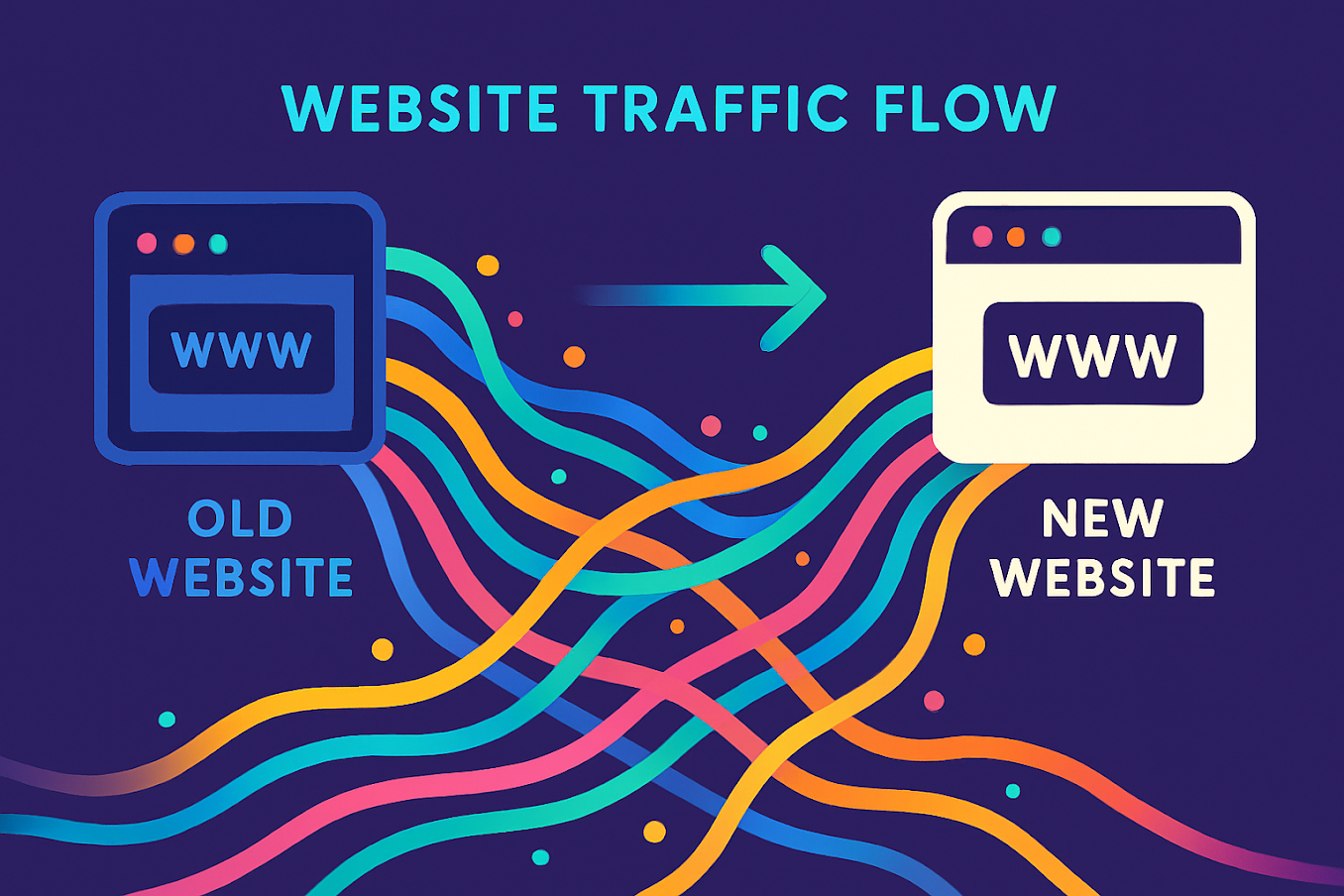Website migration is more than just relocating content from one place to another; it’s a high-stakes operation that can substantially influence your SEO performance. Changing your domain, redesigning your site, or moving to a new CMS are all major steps in how search engines see and index your site. Done correctly, migration can bring a brand refresh and performance improvements. Done poorly, it can bring traffic loss, broken rankings, and a long-slump visibility dip.
Why Website Migration Affects SEO
A detailed map of your site’s URLs, structure, and content relationships is built by search engines. These elements might be changed during a migration, and with them, the risk of disrupting indexing and ranking. Your pages that once performed well might vanish from search results after a migration.
This is bad. So is the possibility of backlinks pointing to pages that produce 404 errors. A sound SEO strategy ensures continuity and prevents avoidable damage.
Moreover, Google’s algorithms consider content stability, internal link signals, and structured metadata to be of great importance. If a site experiences any issues during the migration — like faulty redirects or absent canonical tags, for example — that site could see a significant drop in its trust and rankings. Migration SEO is simple, really: As long as a set of established rules is followed, a site should not see a downturn in its visibility.
Types of Website Migrations
Different types of website migration occur, and they all affect SEO in one way or another. They include:
- Switching Domains: Changing from example.com to newexample.com impacts not only your domain authority and backlinks but also how people recognize your brand.
- Changing from HTTP to HTTPS is crucial for security and trust signals. However, it is necessary to make this transition without breaking links. Here’s our protocol that details the process.
- Platform Movement: Moving to a new Content Management System or eCommerce platform (like from WordPress to Shopify) can affect site speed, URL structure, and how well the site can be crawled.
Restructuring site content, categories, or URLs can confuse search engines—but only if you don’t provide a strong enough redirect map.
Visual alterations might influence load speed, mobile adaptability, and accessibility — all of which influence your ranking.
Key Steps for an SEO-Friendly Website Migration

1. Pre-Migration Audit and Benchmarking
Begin with a complete crawl of your existing website utilizing programs such as Screaming Frog, Ahrefs, or Sitebulb. Establish base measurements for the following metrics:
- Pages that get the most visits and rank for the most keywords
- Sources of backlinks and anchor text.
- Metadata (title tags, descriptions, H1s)
- Linking to different parts of your site can help search engines and users understand your site’s internal structure. The value that each page has can be passed around through internal links. Using a reasonable amount of relevant internal linking throughout your site can help your search engine rankings.
- Speed rankings for web pages
This data is your “before” snapshot. It will serve as a reference to judge and validate the critical aspects lost or retained when you used the 3D migration tool.
2. URL Mapping and 301 Redirects
Every URL that has changed must be accounted for in a redirect map. You should use 301 (permanent) redirects to inform search engines and browsers where the content has gone. This passes approximately 90-99% of link equity and ensures that old backlinks continue to work and have value.
/example/web-design-services → /design-web-services
Refrain from linking redirects in a chain (A → B → C). Always link directly from A to C (A → C) in order to maintain performance and clarity.
3. Change the XML sitemaps and Robots.txt file.
Create a new XML sitemap with the updated URL structure and submit it through Google Search Console. And do check your robots.txt file. Lots of development sites block search engines for privacy reasons — but if that command stays in effect after launch, your live site may be next to disappear from the engines’ index.
4. Before Going Live, Crawl and Test
Test all components in a staging environment before launch:
- Crawling for non-functional links, redirect loops, missing metadata
- Assess Core Web Vitals using tools such as Google Lighthouse.
- Test forms, CTAs, and mobile responsiveness.
More detail about each of these elements.
Forms are an incredibly important part of any mobile app, yet they’re often overlooked. But before you can create a perfect form, you need to understand what makes a good form in general and okay in terms of mobile first.
Call-to-Actions are very nearly the most crucial thing anyone can put in any web app. Yet in the mobile context, they also tend to be overlooked. What makes a good Call-to-Action on mobile?
It is also important to run structured data tests using Google’s Rich Results Test to ensure that schema markup hasn’t been broken.
5. Monitoring and Reporting After the Launch
Even after going live, your work isn’t complete. Here’s a checklist for SEO post-migration to keep an eye on performance:
- Maintain oversight of Google Search Console for any errors related to crawling, indexing problems, or significant declines in the number of impressions.
- Analyze traffic trends using Google Analytics. (Year over Year or Month over Month)
- Ensure no lost link equity by using backlink tools.
- Submit your sitemap again to achieve faster indexing.
- Create alerts for server problems or 404 errors.
We suggest monitoring rankings and traffic on a daily basis for the first two weeks after launch, followed by a weekly check for the subsequent month.
6. Revise Outside Connections
If you can, contact the sites with high authority that link to your previous URLs and ask them to change the links. Even though redirecting via a 301 sends the link equity down the line, having a link point straight to your page is better for both SEO and the user experience.
Common SEO Pitfalls to Avoid
- Neglecting Redirects: A single neglected page can cost hundreds of visits.
- Content Duplication: If not effectively prevented, temporary staging environments might become indexed.
- A slow site speed can be a downside of a migration. Sometimes a migration includes new scripts, media, or uncompressed assets that can introduce that issue. (Think about ways to avoid that!)
- Do Not Update Internal Links: Ensure your internal links direct to the new URLs instead of the old ones via redirects.
When Should You Consider Website Migration?
In some situations, migration is an absolute must; otherwise, it may be necessary, but not quite as much as we sometimes think:
Rebranding, or changing a company’s name, can happen for several reasons:
– The current name is no longer a good fit.
– The name doesn’t resonate or work across several markets that the company operates in.
– There are negative associations or publicity linked to the current name.
– The company is undergoing a significant shift in strategy, business model, or product line that warrants a new name.
– There are legal entanglements with the current name.
Transitioning from an obsolete content management system (CMS) or technology stack.
Changing from HTTP to HTTPS
Bringing together several websites or subdomains
Linearly scaling an app changes the amount of computing resources. This is often done by adding more servers. When doing this, it is important not to forget:
1. **Horizontal scaling offers fault tolerance.** Adding more servers means that in the event one server fails, the app can still be served by the other servers.
2. **A scale-up approach works, but should have limits.** Sometimes servers with more capacity should be considered. This is most effective with data stores. Scaling up works until it doesn’t, but forgetting about breaking points can be disastrous.
Grasping the reasons for your migration leads to a more strategic process. It is arguably the most important aspect of forming a coherent strategy. If you understand your impetus for moving to the cloud, you are much more likely to end up with a suitable process and a resulting cloud environment that meets your needs.
How SEOSets.com Supports Seamless Website Migrations
At SEOSets.com, we focus on overseeing very important website changes with SEO at the very front. Our group of people combines both technical know-how and deep SEO understanding to make sure your site traffic, keyword rankings, and user experience remain unharmed or even get better after the change. From audits before the big change to reports after the site is live, we handle all the important SEO work with great care and expertise.
One of our recent clients changed their domain and their platform. Within two weeks, their traffic was fully back — and within two months, they enjoyed a 20% increase in organic traffic due to much better structure and speed. We achieved this with detailed redirect mapping, vigilant preservation of their metadata, and close monitoring of things like Google Search Console afterward.
SEOSets.com guarantees a smooth, search-friendly, and future-ready transition for your digital medium, whether you’re rebranding, platform-changing, or scaling up. Indeed, their promise is all but set in stone.
Conclusion
You don’t have to lose SEO when you change your website. It isn’t about URL redirects and how to properly implement them. Although that is THE biggest factor in retaining search presence after a site migration, other components are just as crucial. The only way you can almost certainly retain (or even improve upon) the search presence of your old site is to make a well-laid plan, execute it in drastic detail, and monitor the hell out of your new site.
Don’t endanger your ratings. Team up with pros who grasp what is at risk. Let SEOSets.com steer your next site migration with unambiguous confidence, clarity, and results that don’t need to be explained.
Frequently Asked Questions (FAQs)
1. In SEO, what does website migration mean?
Web migration refers to the number of changes made to a website that can affect its performance and appearances, such as website design and structure, URLs, and content. Rather than making a single significant change to a site, web migration is typically a process that involves several moves and adjustments. These can be made for various reasons, including redesigning a site, rebranding, or changing hosts.
Website migration in search engine optimization (SEO) refers to large-scale modifications made to a website’s basic framework, content, operating platform, domain, or design that can affect how search engines index and rank the site. An SEO migration doesn’t just look at the immediate benefits or consequences of a site move—like the 301 redirects mentioned above. It also looks at what the overall changes mean for the site and its search rankings.
2. Will I lose my rankings if I migrate my website?
Not necessarily. If you plan the migration carefully—with proper redirects, metadata preservation, and technical SEO checks—you can maintain (or even improve) your rankings. But if you execute poorly, you might not be able to maintain the same level of rankings.
3. After a migration, how long does it take for SEO to bounce back?
The majority of sites start to regain their previous standing within four to six weeks after a proper migration. Complete recovery can take as long as three months, and in some cases, longer, to reach the full recovery point. The speed of re-crawling and re-indexing of your site by search engines determines largely how fast your site sees gains in migration recovery.
4. Is it necessary to tell Google that I’m moving my site?
Indeed. You ought to turn in your fresh sitemap to Google Search Console. And if you’re switching domains, that’s when you want to use the Change of Address tool. Both of these steps assist Google in grasping what you’ve done and, even more importantly, getting it done.
301 redirects explain everything very clearly, and they also create a structure that is understandable to humans and machines. Both humans and machines understand: a human seeing the structure understands it is an address change, but the underlying message is understood by the machine as well. Address change alert. Clear message to all kinds of readers.
5. What are 301 redirects, and why are they important?
A permanent redirect from one URL to another is called a 301 redirect. It tells search engines that the page has moved and, more importantly, allows most of the original page’s SEO value to be passed along to the new URL. If you don’t set up your 301s properly, you could risk losing some of the ranking power and traffic of the original page.
6. If my site was moved poorly before, can it still be fixed by SEOSets.com?
Definitely. SEOSets.com can execute a post-migration SEO audit, pinpoint lost traffic sources, restore missing redirects, correct crawl errors, and reoptimize pages that were affected. It’s often possible to reverse the damage—even if a handful of SEO is the only thing keeping your company from going under.

